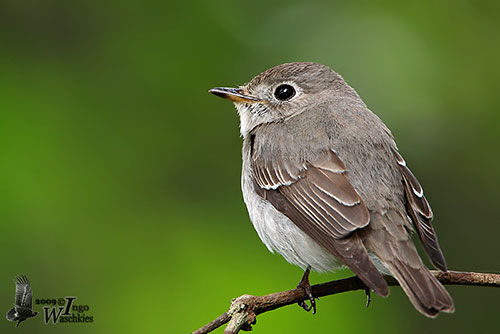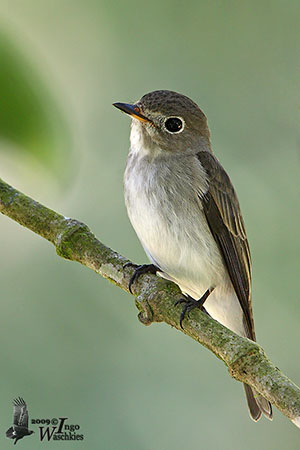
Fr: Gobemouche brun
Ang: Asian Brown Flycatcher
All: Braunschnäpper
Esp: Papamoscas Pardo
Ita: Pigliamosche della Dauria
Nd: Bruine Vliegenvanger
Sd: glasögonflugsnappare
Photographers:
Didier Buysse
Vision d’Oiseaux
Ingo Waschkies
Bird Photography
Text by Nicole Bouglouan
Sources:
HANDBOOK OF THE BIRDS OF THE WORLD Vol 11 by Josep del Hoyo, Andrew Elliott and David Christie - Lynx Edicions - ISBN: 849655306X
A Field Guide to the Birds of South-East Asia by Craig Robson. New Holland Publishers. ISBN: 9781780090498
Birds of Borneo De Susan Myers – Editeur : Bloomsbury Publishing, 2016 – ISBN: 1472924460, 9781472924469 – 320 pages
Field Guide to the Birds of East Asia De Mark Brazil - Editeur : Bloomsbury Publishing, 2020 – ISBN: 1472981146, 9781472981141 – 528 pages
What Bird-The ultimate Bird Guide (Mitchell Waite
Brown, Siberian and Grey-streaked Flycatchers: identification and ageing
THE AVIANWEB - Beauty of Birds (Sibylle Faye)
Wikipedia, the free encyclopaedia
Asian Brown Flycatcher
Muscicapa dauurica
Passeriformes Order – Muscicapidae Family
INTRODUCTION:
The Asian Brown Flycatcher breeds in Japan, E Siberia and the Himalayas, and it winters in S Asia from S India and Sri Lanka E to Indonesia. The species is occasionally vagrant in Aleutian Islands, Pribilof Islands, and St. Lawrence Island in the Bering Sea.
It frequents open forests when breeding and occurs in similar habitats in the winter range, but also in parks, wooded gardens and orchards. It feeds primarily on insects and often hunts from perches. This species nests in a cup-shaped structure placed on bare horizontal branch, several metres above the ground.
The Asian Brown Flycatcher is described as common to locally common throughout the range. The population appears stable and the species is not globally threatened.
DESCRIPTION OF THE BIRD:
Biometrics:
Length: 13 cm
Wingspan: 20 cm
Weight: 11 g
The Asian Brown Flycatcher has brownish-grey head and upperparts, with pale greyish fringes on wing-coverts and tertials. The flight-feathers are browner with pale buff edges. The tail is brown with narrow white tip.
On the underparts, chin and centre of throat are white, whereas throat and breast sides are variably suffused brownish-grey. The area from belly to undertail-coverts is white.

On the head, we can see a broad whitish line on the lores, especially in fresh plumage, and an indistinct, short, dark moustachial stripe.
The pointed bill is black with yellowish base of lower mandible. The eyes are dark brown, surrounded by whitish eyering. Legs and feet are blackish.
The bird in worn plumage appears greyer above and paler below.
Male and female are similar.
The juvenile resembles adult but the upperparts are spotted buffish, and secondaries and tertials have buffy edges. The underparts are whitish, with fine dark scaling on the breast.
SUBSPECIES AND RANGE:
The Asian Brown Flycatcher has three subspecies.
M.d. dauurica (described above) is found in C Siberia and N Mongolia to Sakhalin, Japan and Korea. It winters in S China and SE Asia.
M.d. poonensis occurs in N Pakistan to Bhutan. It winters in peninsular India, Sri Lanka, Andamans and Nicobars, usually up to 1,000 metres of elevation.
This race is paler and browner above, whereas on the underparts, throat, breast and flanks are more mottled in fresh plumage. The white eyering is less conspicuous and the bill is deeper with mostly pale lower mandible.
M.d. siamensis is found in SE Myanmar to NW Thailand and S Vietnam. It is subject to some movements to C Thailand.
This race has browner upperparts and wings, and duller underparts. The bill is paler with dull yellowish mandible showing a dusky tip. White eyering and lores are less conspicuous.
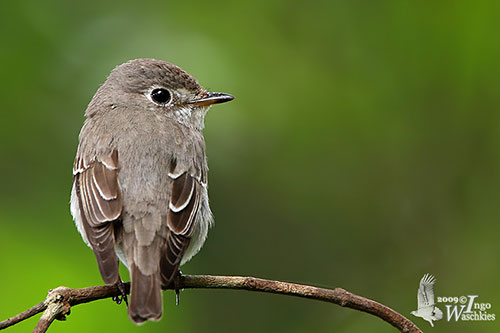
HABITAT:
The Asian Brown Flycatcher generally breeds in mature mixed broadleaf forest in temperate zone, whereas in southern boreal region, it frequents mainly larches and birches in C and E Siberia.
During winter, it is also found in swamp forest, large wooded gardens, orchards, mangroves and scrub.
On migration, it frequents a wider range of wooded and open habitats.
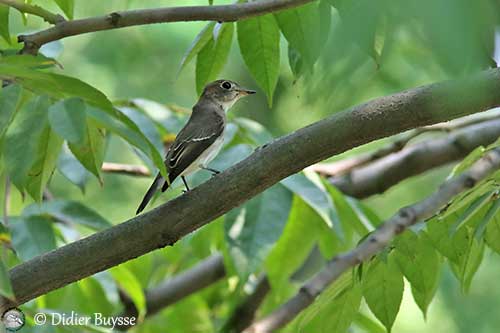
CALLS AND SONGS: SOUNDS BY XENO-CANTO
The Asian Brown Flycatcher gives a thin, sharp “tse-ti-ti-ti-ti” or a loud “seet-seet”. The alarm call is a soft “tsr-tsr” and the flight call is a thin “siht”.
Outside of breeding season, it gives a short “tzi”, “tsee” or “neep” and a low “churr”.
The song is a complex series of short trills interspersed with 2-3 whistled notes “chi jo chi-chi-chi cho-chu-chu-chu”.
BEHAVIOUR IN THE WILD:
The Asian Brown Flycatcher feeds primarily on insects such as beetles, stoneflies, bugs, wasps and larvae. It also takes small fruits depending on the season.
It hunts from perch, often on an exposed tree branch. It remains motionless and erect while waiting for a passing prey. When it is located, the bird takes flight and catches it in the air before to return to the perch.
It also gleans prey from foliage and tree bark. It may drop to the ground to catch some insect among the grass. It forages alone or in pairs.
Like numerous Muscicapidae, it often adopts an upright stance and flicks the wings frequently while the tail is depressed.
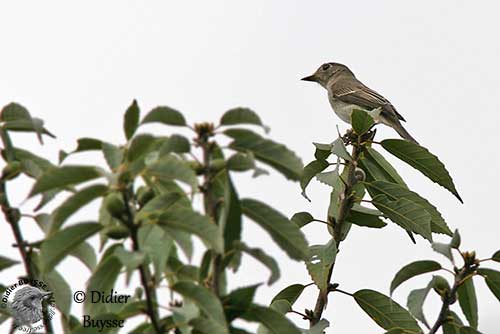
The Asian Brown Flycatcher is territorial during the breeding season. The pairs nest solitary. These birds are mainly monogamous, although some species are polygynous.
The courtship displays are not described, but courtship feeding by male to female is often reported. The nest is a cup-shaped structure placed on bare horizontal branch.
The Asian Brown Flycatcher is migratory and spends the winter in tropical southern Asia where it arrives from September to mid-October. The species is resident in C and SW India, S Myanmar and S Vietnam.
They leave the wintering areas in April and early May, and arrive in E Russia, Sakhalin and Kuril Islands throughout May and early June.
The species is vagrant in Aleutian Islands (Alaska), and a rare vagrant to W Europe with records from Britain, Denmark and Sweden.
The race M.d. siamensis is resident in SE Asia.
The flight of the Asian Brown Flycatcher is weak, fluttering and direct, with shallow wingbeats.
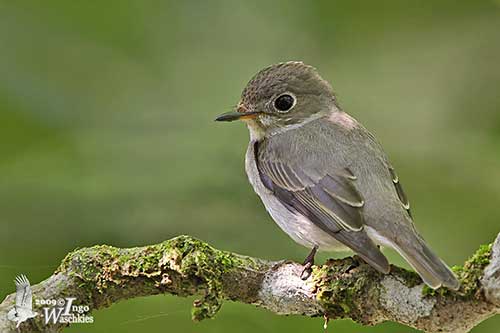
REPRODUCTION OF THIS SPECIES:
The breeding season occurs in May/July in N, and in April/June in S. This species produces a single brood, at least in N.
The female builds a cup-shaped nest made of lichen, moss and grasses, lined with plant fibres and feathers. It is placed on bare horizontal branch between 2 and 18 metres above the ground, or sometimes in tree fork.
The female lays 2-4 olive-grey eggs and incubates alone during 11-13 days. She is fed by the male during this period. The young are fed by both parents.
From an observation of the subspecies M.d. poonensis in India, the young may fledge 12-14 days after hatching.
PROTECTION / THREATS / STATUS:
The Asian Brown Flycatcher is usually common to locally common throughout the range.
The size of the population is unknown, but it is suspected to be stable.
The species is not globally threatened, and the Asian Brown Flycatcher is currently evaluated as Least Concern.
